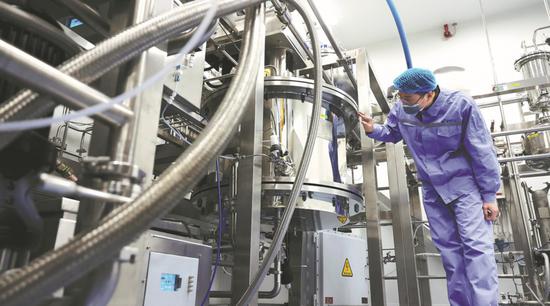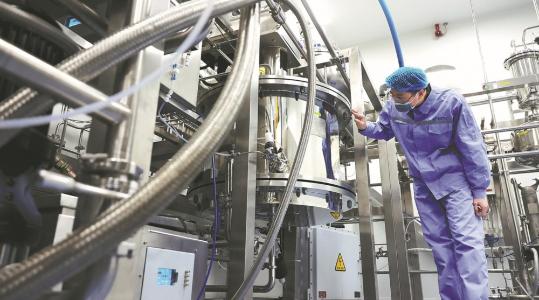Guideline promotes pharma innovation

An employee checks equipment at a pharmaceutical plant in Lianyungang, Jiangsu province. (GENG YUHE/FOR CHINA DAILY)
China has adopted a guideline to promote the development and availability of innovative drugs, with price management improvements, medical insurance payments, commercial insurance coverage, as well as investment and financing topping the work agenda.
Addressing the bottlenecks of pricing, payments and the dominance of incremental innovation are crucial steps for China to unlock the full potential of its pharmaceutical sector, analysts said, calling for the introduction of specific policy measures at an early date.
The National Medical Products Administration has granted approvals for a total of 82 innovative drugs and 138 innovative medical devices from 2022 through the end of May this year. Notably, in the first five months alone, 20 innovative drugs and 21 innovative medical devices have received regulatory clearance.
While the development of innovative drugs continues to gain momentum, the sector stands in stark contrast to the cooling financing situation. Domestic healthcare big data platform yaozh.com said the number of financing projects and the total funding amount for new drugs have been steadily declining over the past four years.
This decline is in sharp contrast to the historical peak witnessed in 2021 when both financing projects and funding amounts reached their highest levels. Recent figures are approaching historical lows, said yaozh.com.
The newly introduced guideline has generated optimism among industry stakeholders and is expected to have a positive impact on the pharmaceutical market, said Chen Hao, director of the pharmaceutical policy and management study center at Tongji Medical College, which is part of the Huazhong University of Science and Technology.
The current pricing mechanisms and payment systems pose challenges for reimbursement and market access for innovative drugs and have repercussions on their valuation, making it challenging for pharmaceutical companies to realize their full potential, Chen said.
By establishing a pricing mechanism that accounts for the investment and risks associated with developing innovative drugs, China will encourage continued investments in research and development. This, in turn, will drive the creation of more groundbreaking treatments, benefiting patients and advancing medical progress, Chen said.
Meanwhile, China could draw inspiration from international practices by supporting commercial insurance to include more innovative drugs within their coverage, allowing commercial insurance to take the lead in funding these treatments, said Zheng Yufen, founder of In Capital, an asset management firm focusing on the healthcare sector.
In 2023, commercial health insurance payments for innovative drugs in China reached 7.4 billion yuan ($1.02 billion), representing 5.3 percent of the overall market, said a report jointly released by China Re Life, Boston Consulting Group and Shanghai MediTrust Health in April.
Between 2019 and 2023, the compound annual growth rate of commercial health insurance payments for innovative drugs was 25 percent, the report added.
The aim is to establish a collaborative linkage between medical and nonmedical insurance, creating a diversified payment mechanism that incentivizes pharmaceutical companies to increase R&D investments, thus fostering a positive cycle for industry development, Zheng said.
In addition, recognizing the importance of bridging the gap between R&D and commercialization, the guideline places emphasis on policies aimed at facilitating investment and financing in the pharmaceutical sector.
The lengthy and complex nature of drug development necessitates significant financial resources, spanning various stages, from initial research to clinical trials and commercialization, said Liu Liping, founder and chairman of HighTide Therapeutics.

